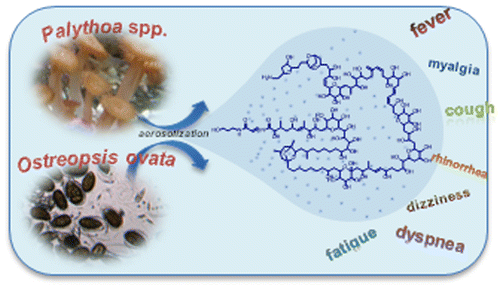Toxins related to 'red tides' found in home aquarium

Many shore residents and beach-goers are already familiar with the health risks of "red tide," algal blooms along coastlines that can trigger respiratory illness and other effects in people who inhale the toxins the algae release. Now in ACS' journal Environmental Science & Technology, scientists report new evidence that similar effects can occur on a much smaller scale among home aquaria owners.
Raising brightly colored tropical fish and coral in a home aquarium is like displaying a living work of art. But unlike art, aquaria are dynamic mini-ecosystems, and some can even release harmful toxins very similar to those that algal blooms release. Some owners have reported fevers, difficulty breathing, flu-like symptoms and other health problems after using hot water to clean their aquaria. Hot water on rocks that harbor algae and other critters creates steam that can then be inhaled. But there is little scientific evidence to shore up the link between aquaria and negative health effects. Carmela Dell'Aversano and colleagues wanted to explore the potential connection.
The researchers developed a method to rapidly test aquaria for toxins. They used their procedure to sample the soft coral and synthetic seawater from a home system when a family of four in the Netherlands fell ill and ended up in the hospital 45 minutes after cleaning their aquarium. The samples had high levels of palytoxins, which are among the most potent non-protein marine toxins known and a possible cause of red-tide health effects. Although the results don't prove cause and effect, the researchers say their findings provide further support for the association.
More information: Luciana Tartaglione et al. Determination of Palytoxins in Soft Coral and Seawater from a Home Aquarium. Comparison between - and -Related Inhalatory Poisonings , Environmental Science & Technology (2015). DOI: 10.1021/acs.est.5b05469
Abstract
Anecdotal reports exist of aquarium hobbyists that experienced severe respiratory distress and/or skin injury following cleaning operation of home aquaria containing Palythoa sp. soft corals. Hundreds of cases of respiratory illness and/or dermatitis have been recorded in proximity to the sea concomitantly with algal blooms of Ostreopsis spp. in the Mediterranean area. Both Palythoa spp. and Ostreopsis spp. contain congeners of palytoxin, a highly potent toxin whose inhalation hazard is however unknown. In this study, we demonstrate the presence of high levels of palytoxins (palytoxin and hydroxypalytoxin) in both soft coral and seawater from a home marine aquarium involved in the poisoning of a whole family. Due to the high toxin levels found in seawater, a procedure for a rapid and efficient determination of palytoxin in seawater was setup. A comparison of symptoms of Palythoa- and Ostreopsis-related inhalatory poisonings showed many similarities including fever, respiratory distress, nausea, and flu-like symptoms. From the chemical and symptomatological data reported herein it is reasonable to hold palytoxins responsible for respiratory disorders following inhalation. Although the exact mechanism through which palytoxin congeners exert their inhalatory toxicity is still unknown, this represents a step toward demonstrating that palytoxin congeners exert toxic effects through inhalation both in natural environments and in the surroundings of private and public aquaria.
Journal information: Environmental Science & Technology
Provided by American Chemical Society



















